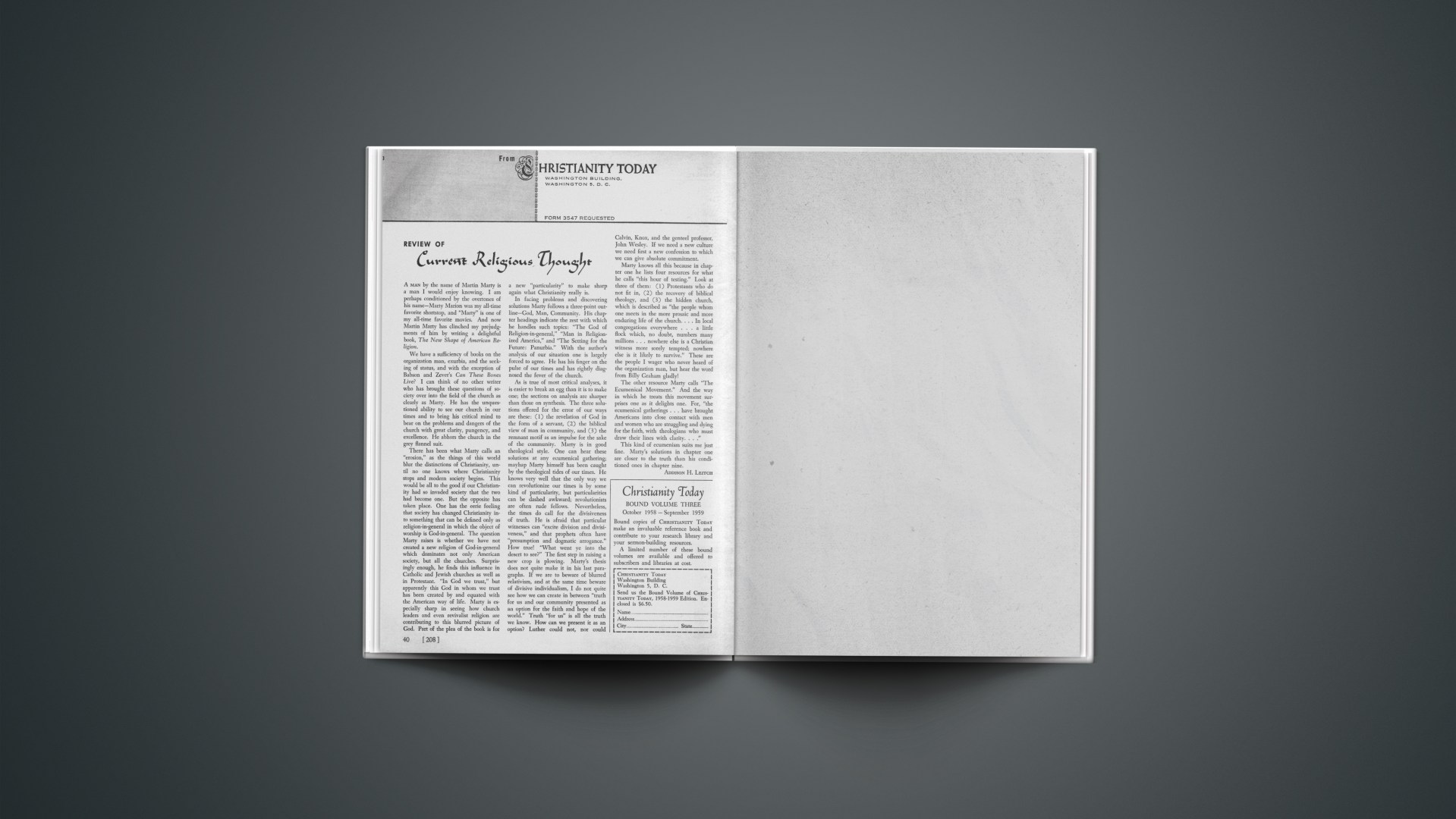A man by the name of Martin Marty is a man I would enjoy knowing. I am perhaps conditioned by the overtones of his name—Marty Marion was my all-time favorite shortstop, and “Marty” is one of my all-time favorite movies. And now Martin Marty has clinched my prejudgments of him by writing a delightful book, The New Shape of American Religion.
We have a sufficiency of books on the organization man, exurbia, and the seeking of status, and with the exception of Babson and Zever’s Can These Bones Live? I can think of no other writer who has brought these questions of society over into the field of the church as clearly as Marty. He has the unquestioned ability to see our church in our times and to bring his critical mind to bear on the problems and dangers of the church with great clarity, pungency, and excellence. He abhors the church in the grey flannel suit.
There has been what Marty calls an “erosion,” as the things of this world blur the distinctions of Christianity, until no one knows where Christianity stops and modern society begins. This would be all to the good if our Christianity had so invaded society that the two had become one. But the opposite has taken place. One has the eerie feeling that society has changed Christianity into something that can be defined only as religion-in-general in which the object of worship is God-in-general. The question Marty raises is whether we have not created a new religion of God-in-general which dominates not only American society, but all the churches. Surprisingly enough, he finds this influence in Catholic and Jewish churches as well as in Protestant. “In God we trust,” but apparently this God in whom we trust has been created by and equated with the American way of life. Marty is especially sharp in seeing how church leaders and even revivalist religion are contributing to this blurred picture of God. Part of the plea of the book is for a new “particularity” to make sharp again what Christianity really is.
In facing problems and discovering solutions Marty follows a three-point outline—God, Man, Community. His chapter headings indicate the zest with which he handles such topics: “The God of Religion-in-general,” “Man in Religionized America,” and “The Setting for the Future: Panurbia.” With the author’s analysis of our situation one is largely forced to agree. He has his finger on the pulse of our times and has rightly diagnosed the fever of the church.
As is true of most critical analyses, it is easier to break an egg than it is to make one; the sections on analysis are sharper than those on synthesis. The three solutions offered for the error of our ways are these: (1) the revelation of God in the form of a servant, (2) the biblical view of man in community, and (3) the remnant motif as an impulse for the sake of the community. Marty is in good theological style. One can hear these solutions at any ecumenical gathering; mayhap Marty himself has been caught by the theological tides of our times. He knows very well that the only way we can revolutionize our times is by some kind of particularity, but particularities can be dashed awkward; revolutionists are often rude fellows. Nevertheless, the times do call for the divisiveness of truth. He is afraid that particular witnesses can “excite division and divisiveness,” and that prophets often have “presumption and dogmatic arrogance.” How true! “What went ye into the desert to see?” The first step in raising a new crop is plowing. Marty’s thesis does not quite make it in his last paragraphs. If we are to beware of blurred relativism, and at the same time beware of divisive individualism, I do not quite see how we can create in between “truth for us and our community presented as an option for the faith and hope of the world.” Truth “for us” is all the truth we know. How can we present it as an option? Luther could not, nor could Calvin, Knox, and the genteel professor, John Wesley. If we need a new culture we need first a new confession to which we can give absolute commitment.
Marty knows all this because in chapter one he lists four resources for what he calls “this hour of testing.” Look at three of them: (1) Protestants who do not fit in, (2) the recovery of biblical theology, and (3) the hidden church, which is described as “the people whom one meets in the more prosaic and more enduring life of the church.… In local congregations everywhere … a little flock which, no doubt, numbers many millions … nowhere else is a Christian witness more sorely tempted; nowhere else is it likely to survive.” These are the people I wager who never heard of the organization man, but hear the word from Billy Graham gladly!
The other resource Marty calls “The Ecumenical Movement.” And the way in which he treats this movement surprises one as it delights one. For, “the ecumenical gatherings … have brought Americans into close contact with men and women who are struggling and dying for the faith, with theologians who must draw their lines with clarity.…”
This kind of ecumenism suits me just fine. Marty’s solutions in chapter one are closer to the truth than his conditioned ones in chapter nine.










